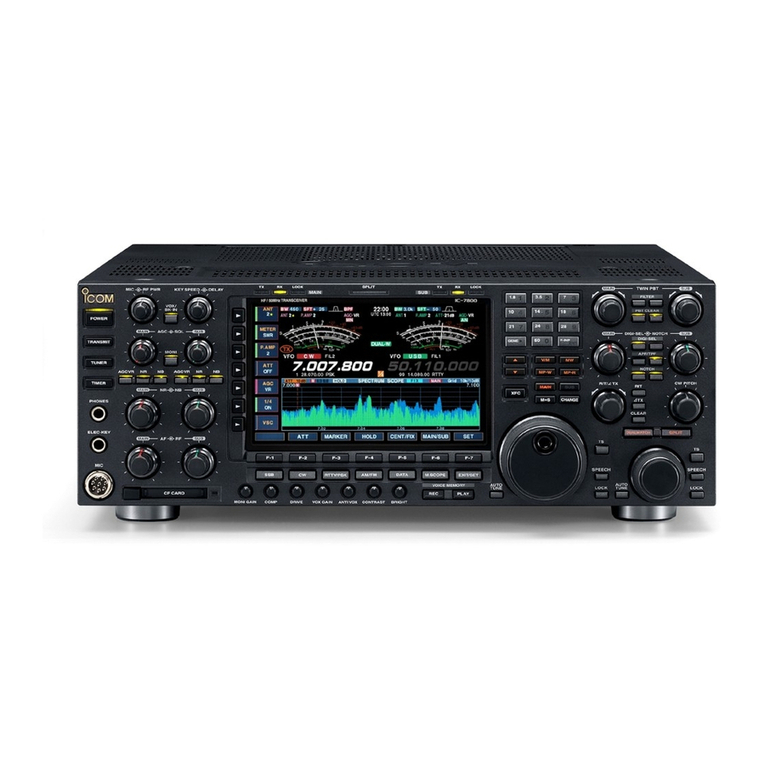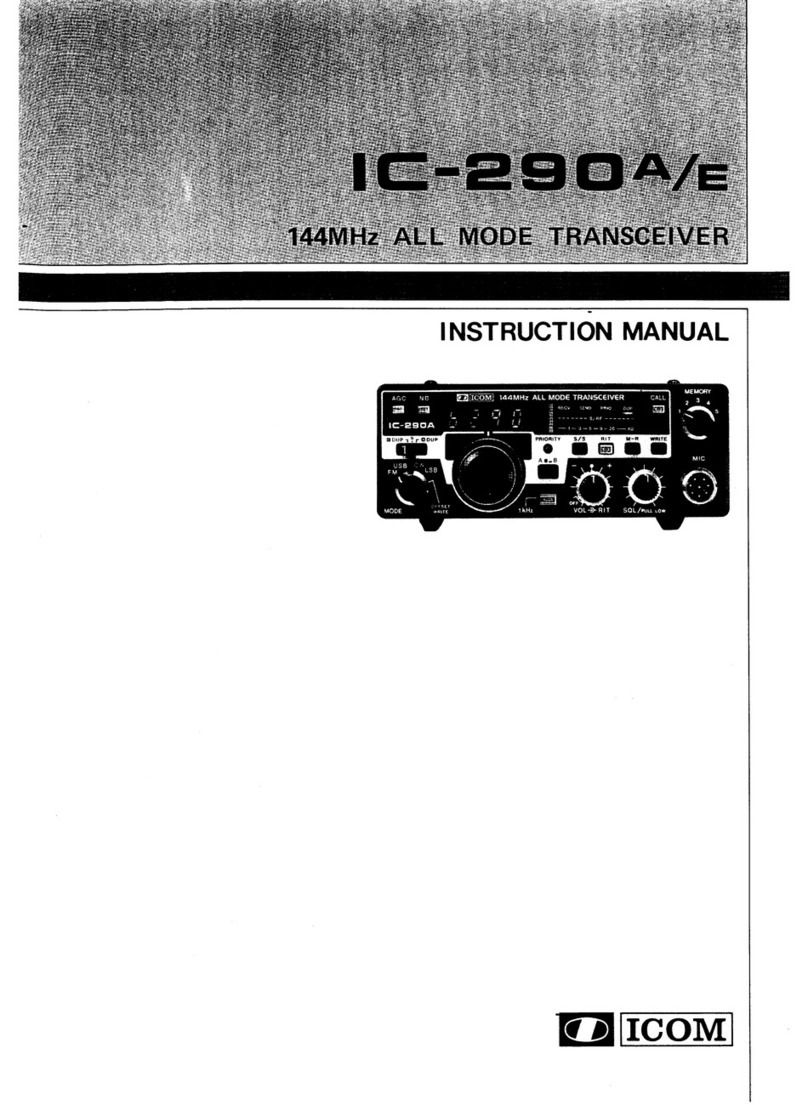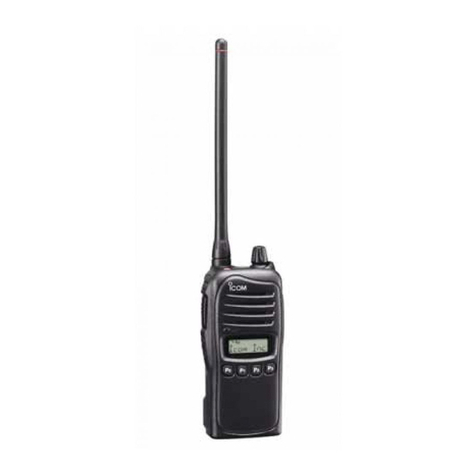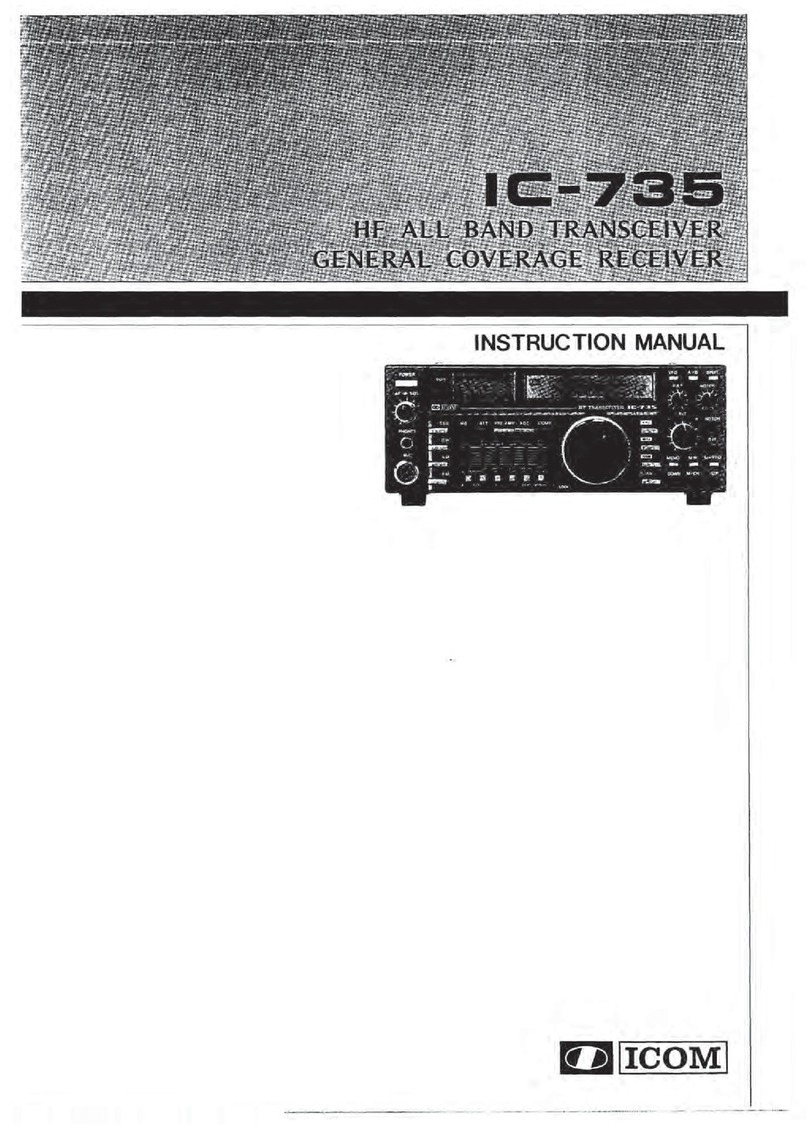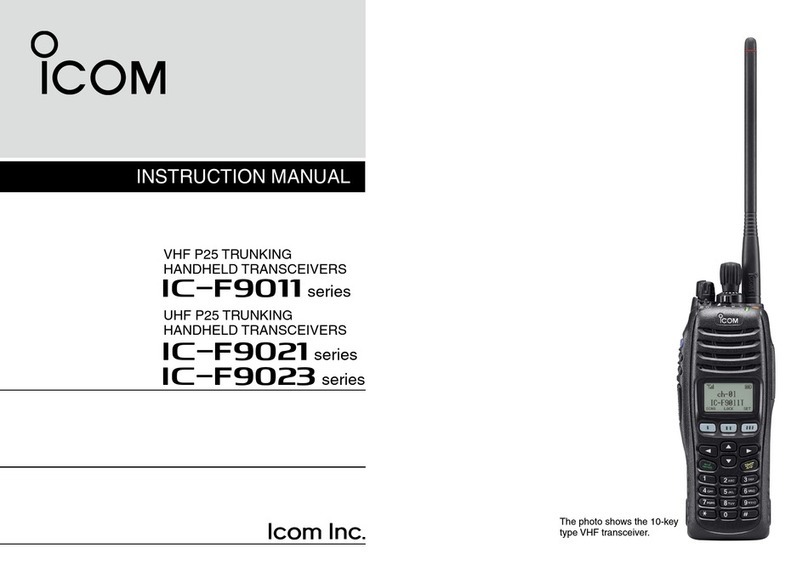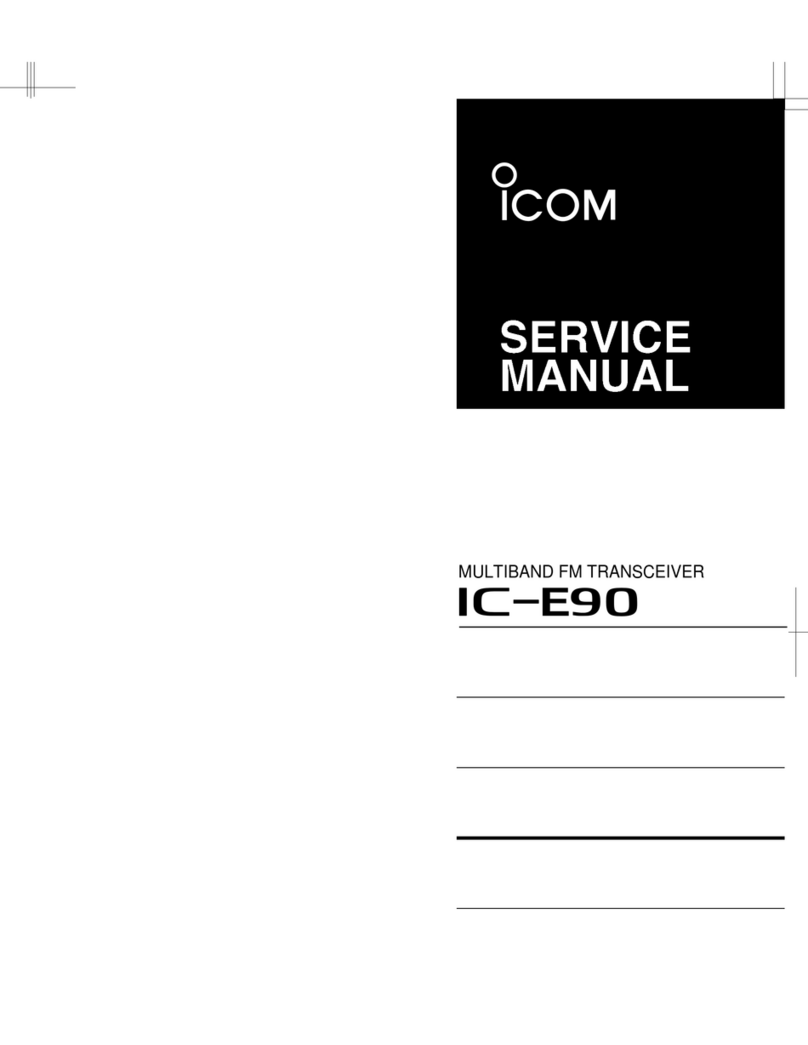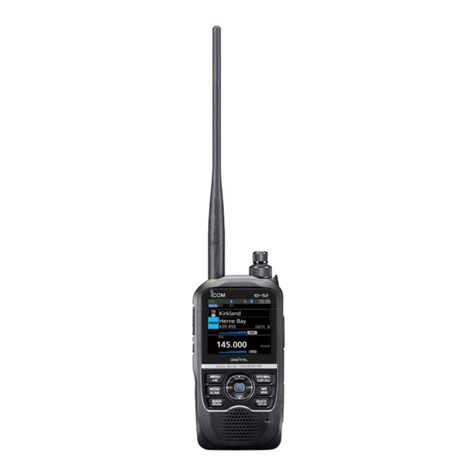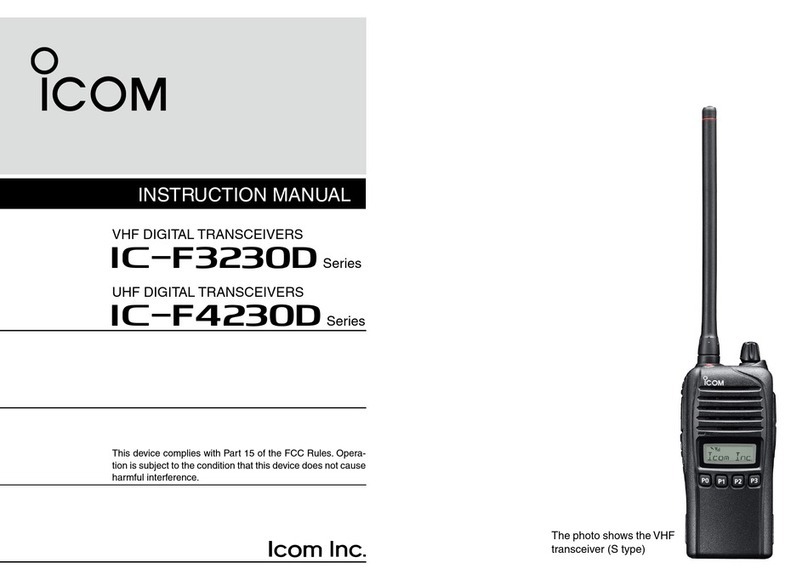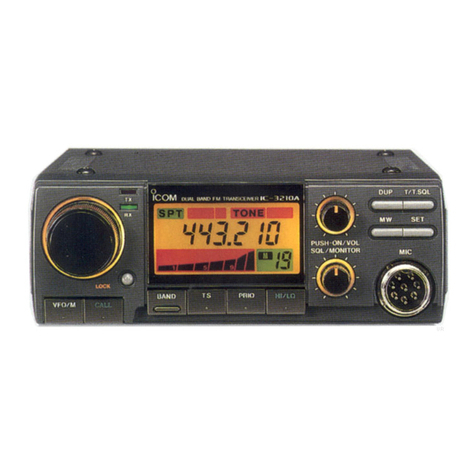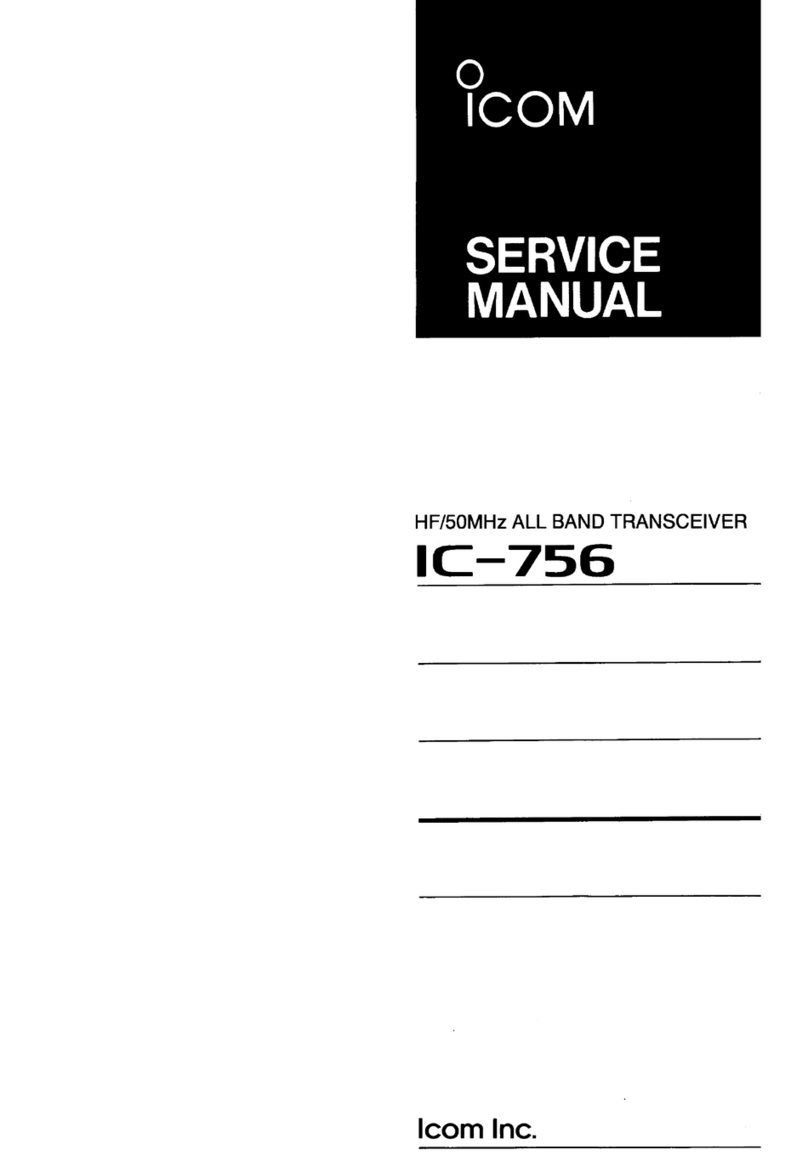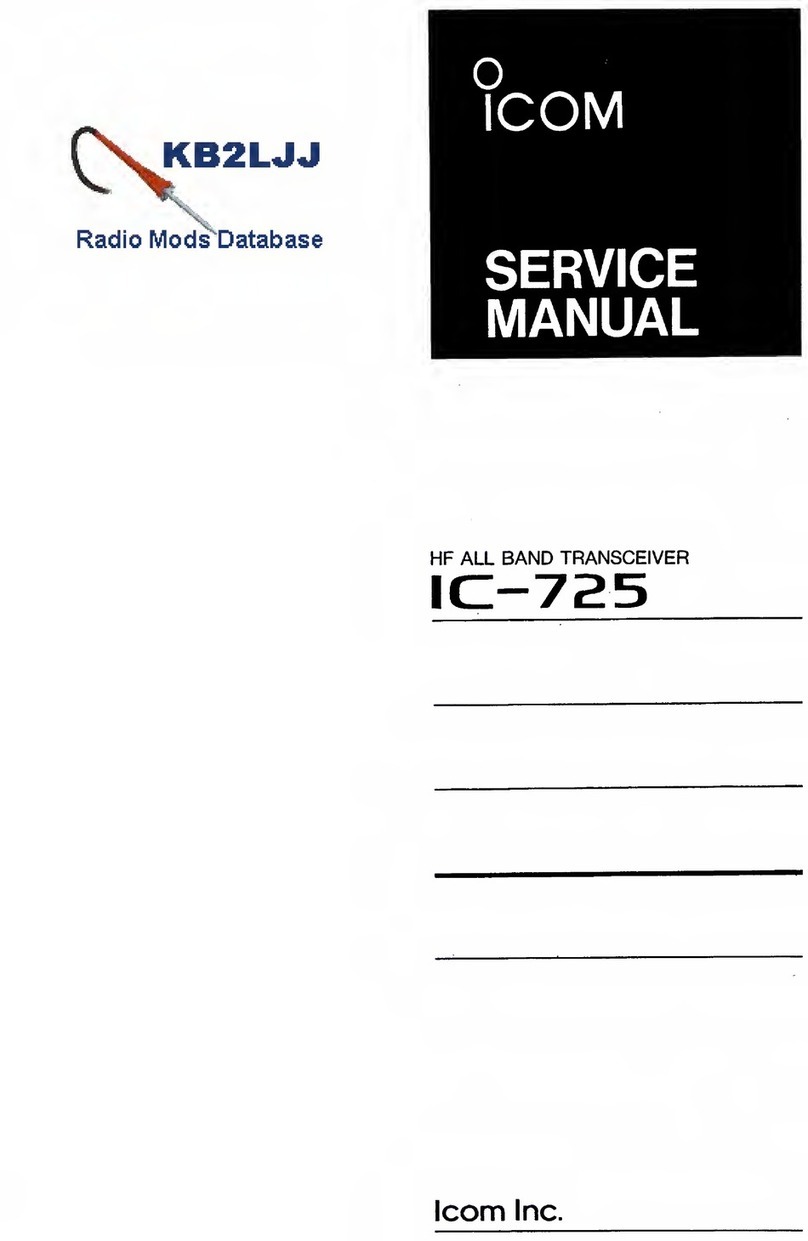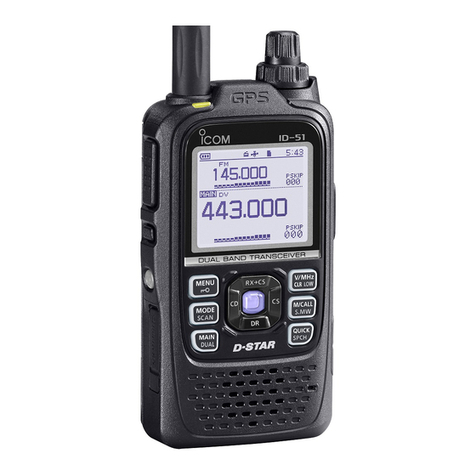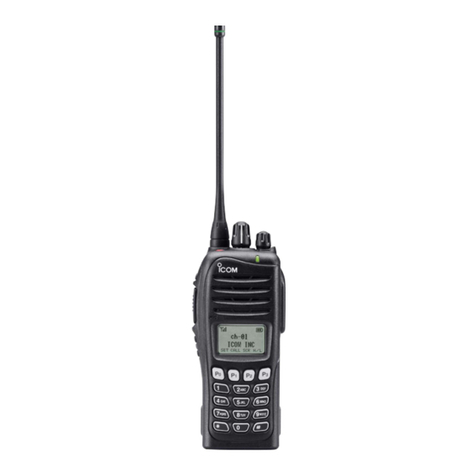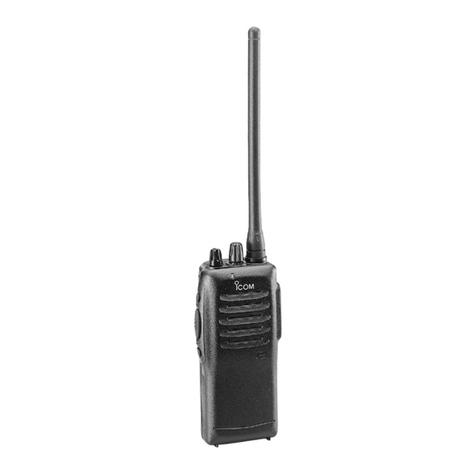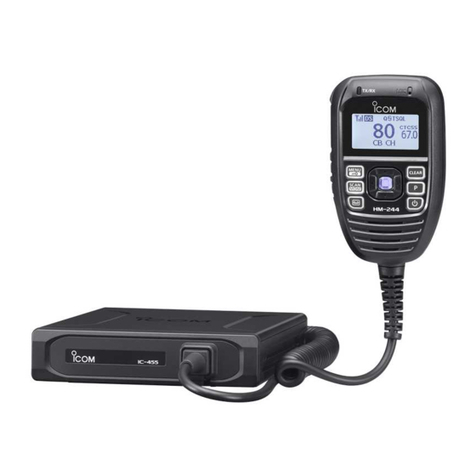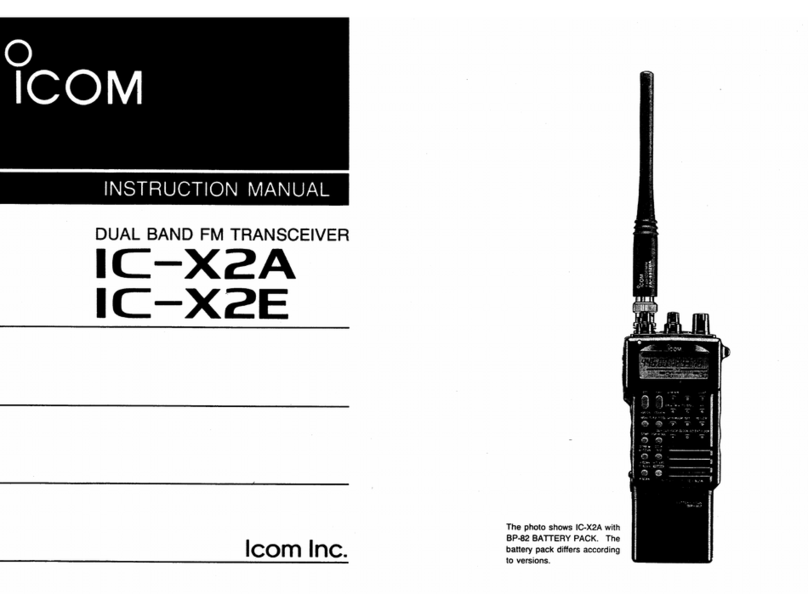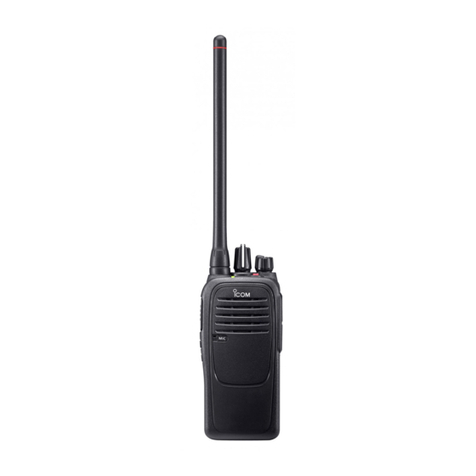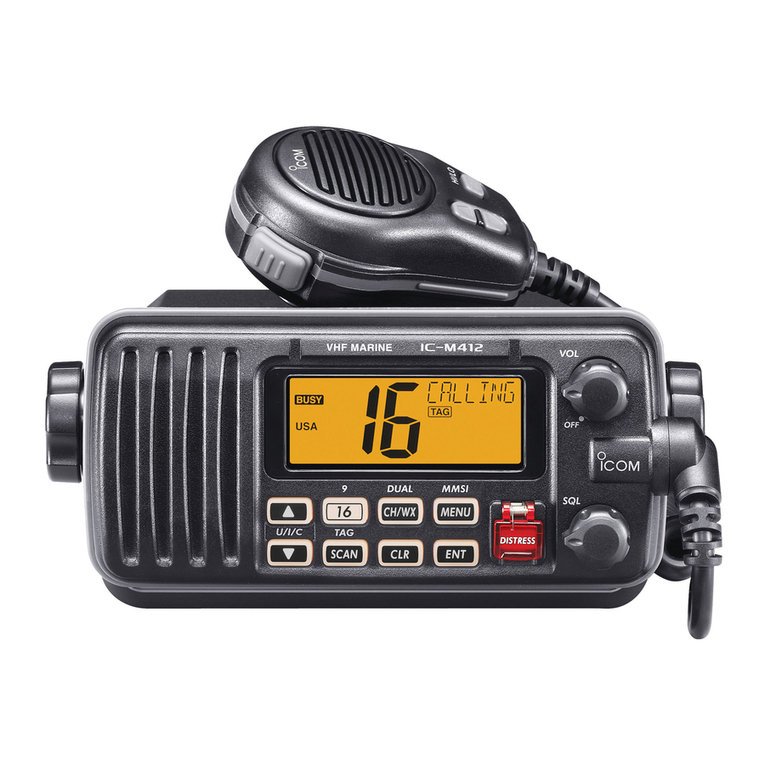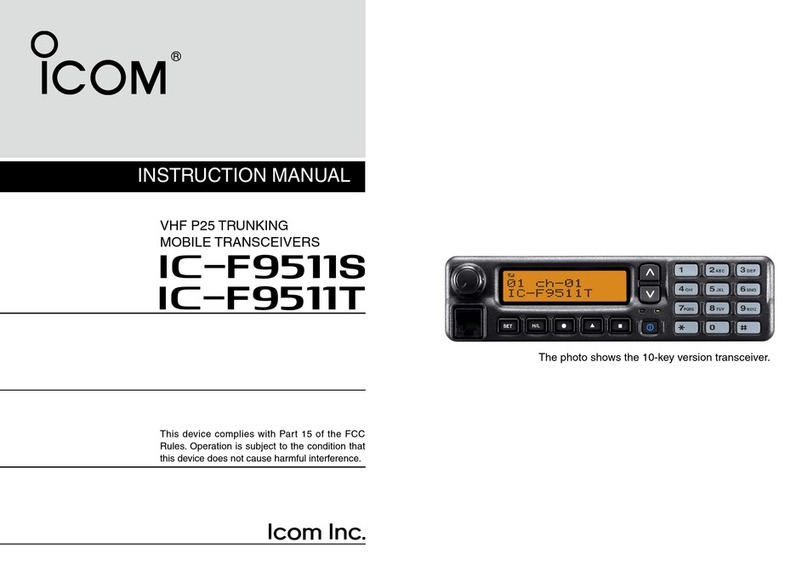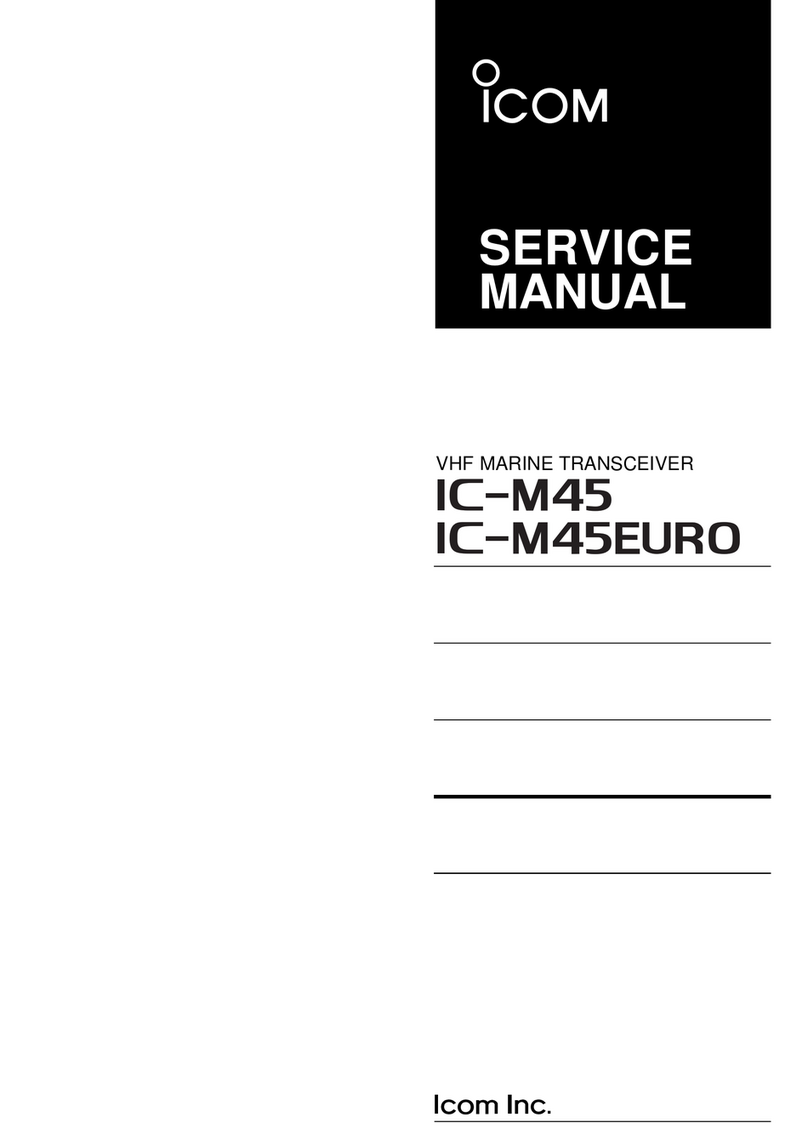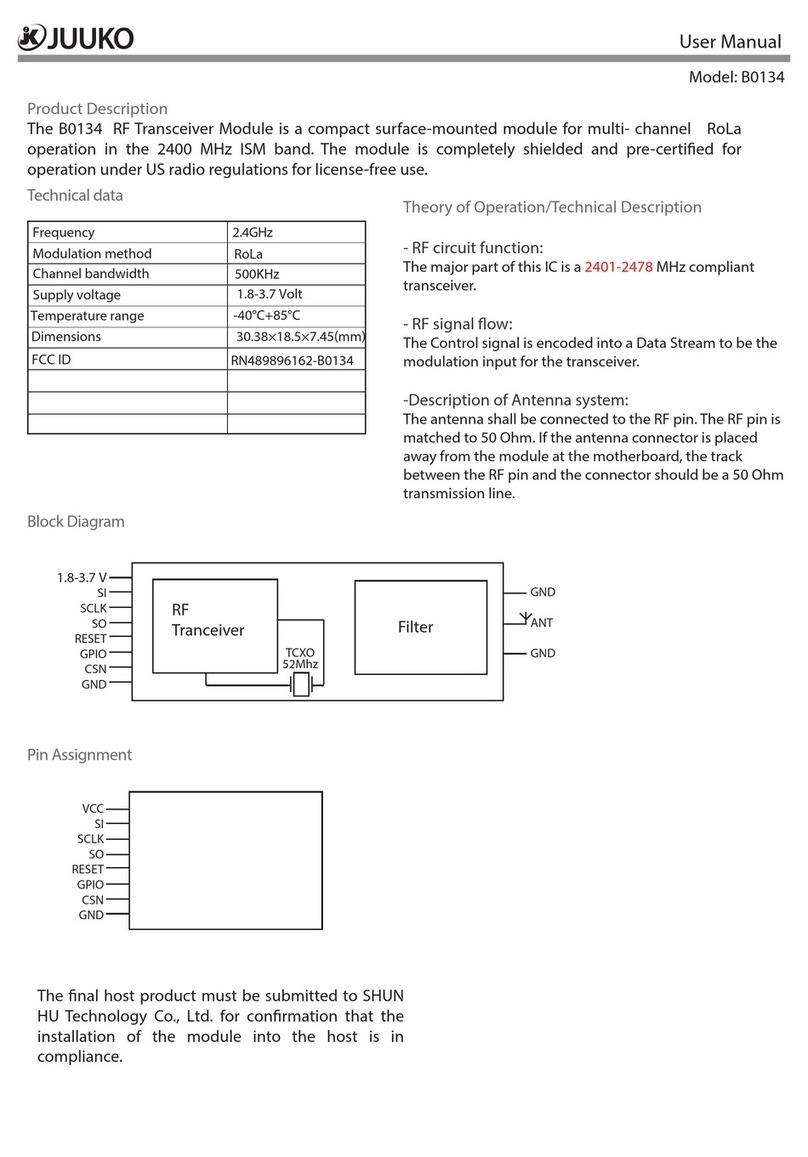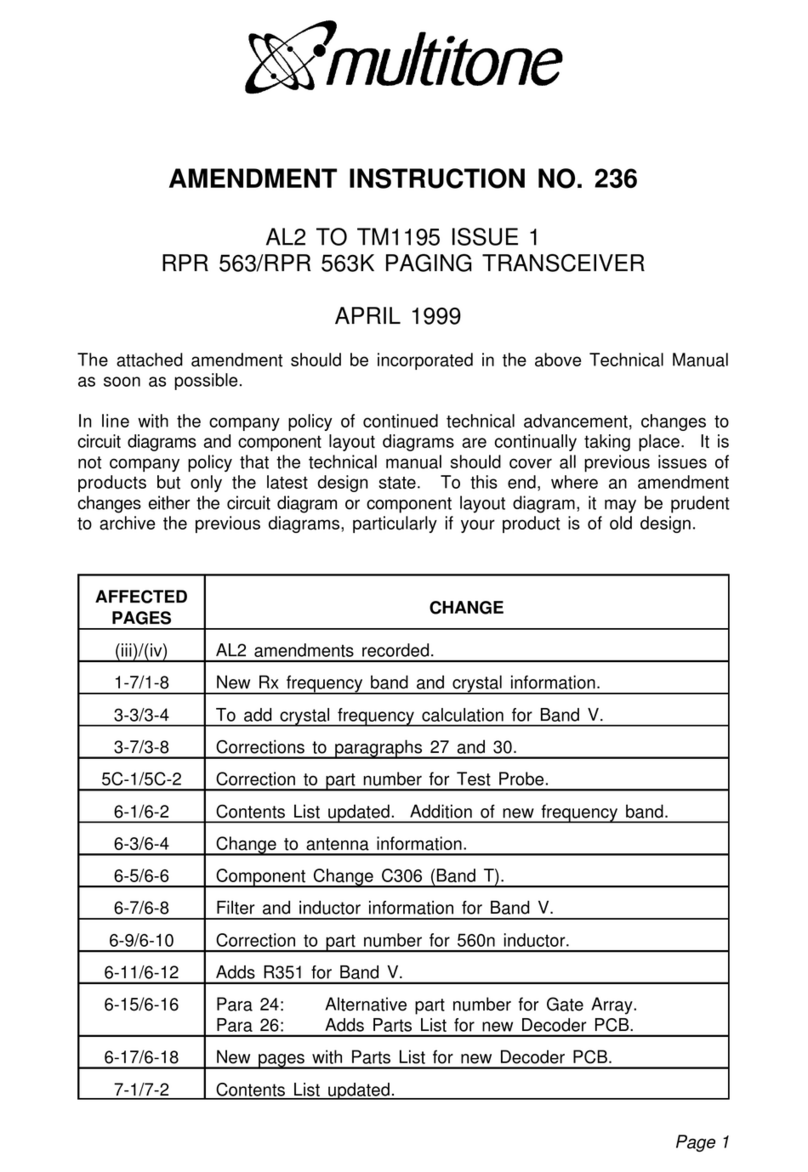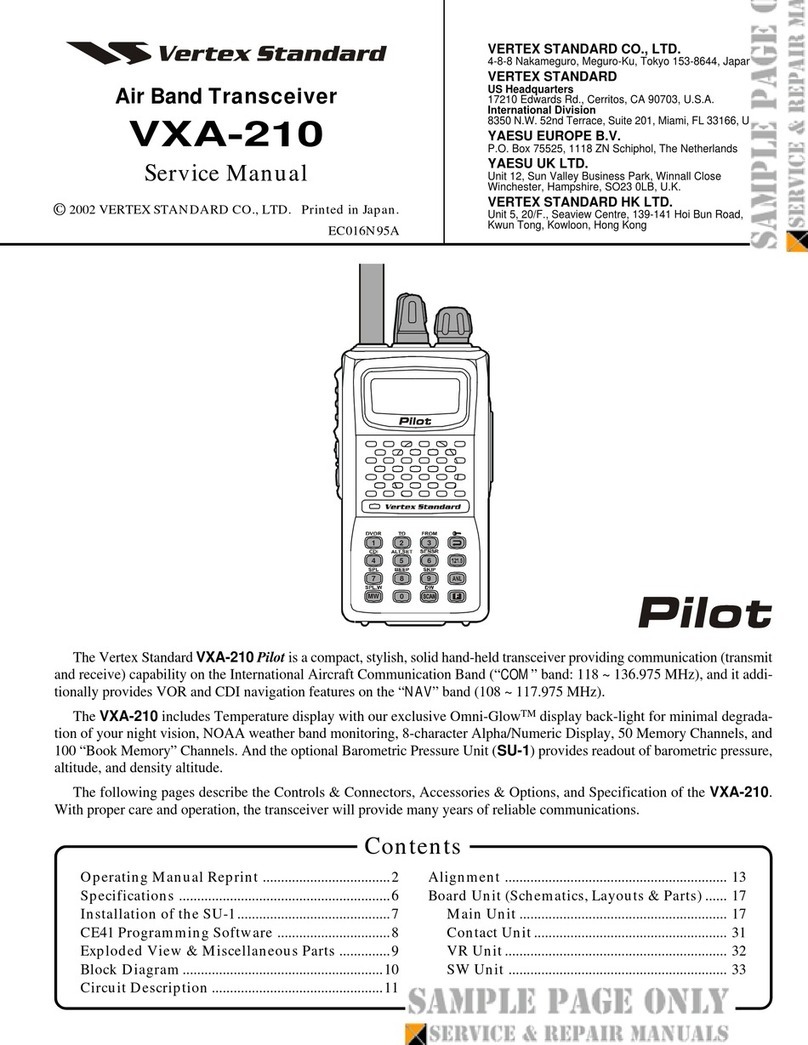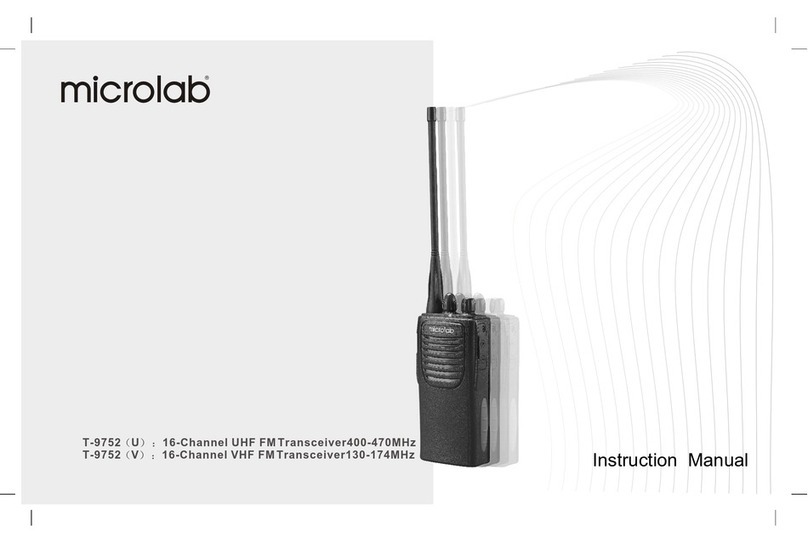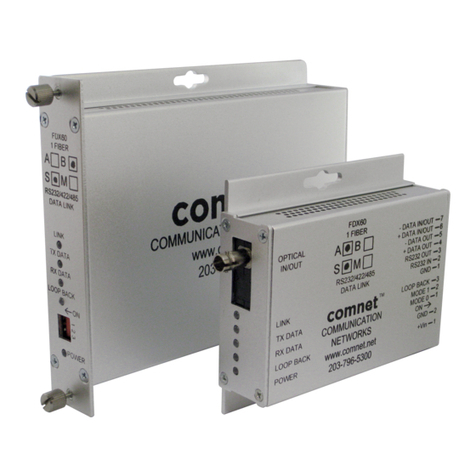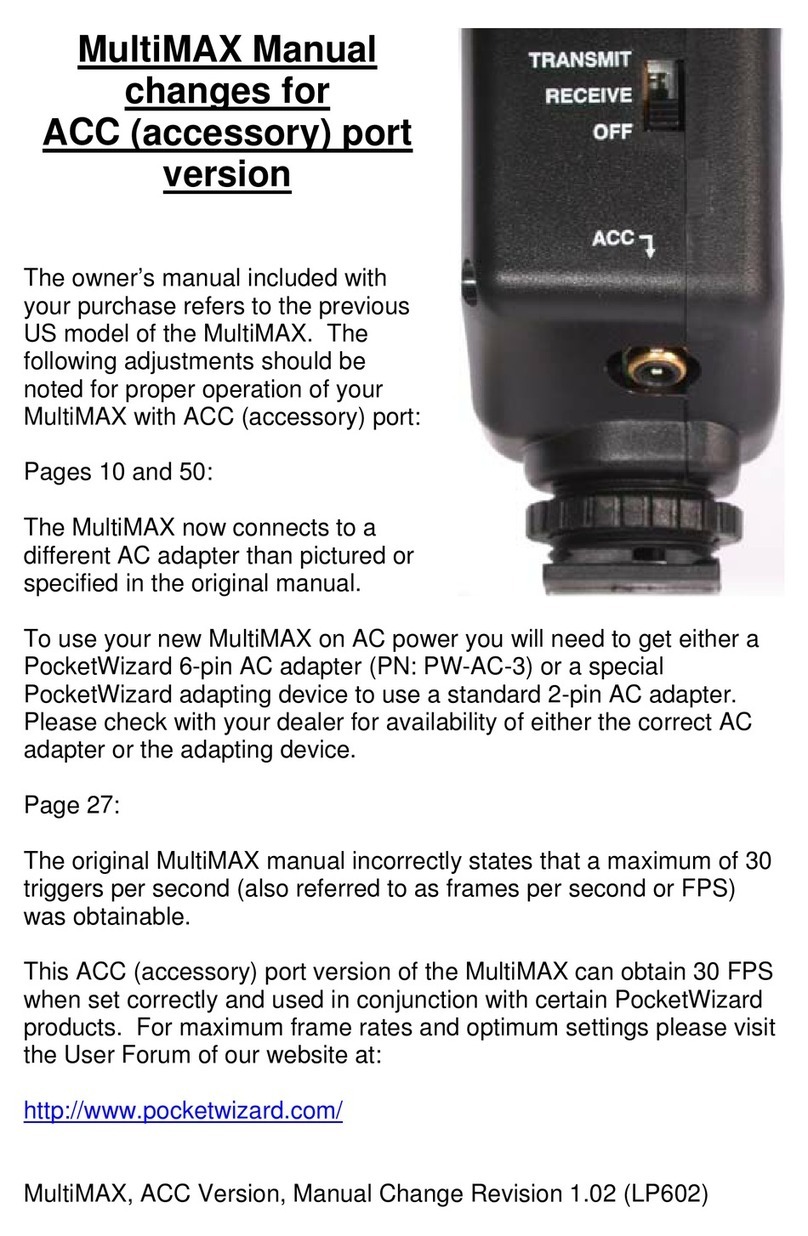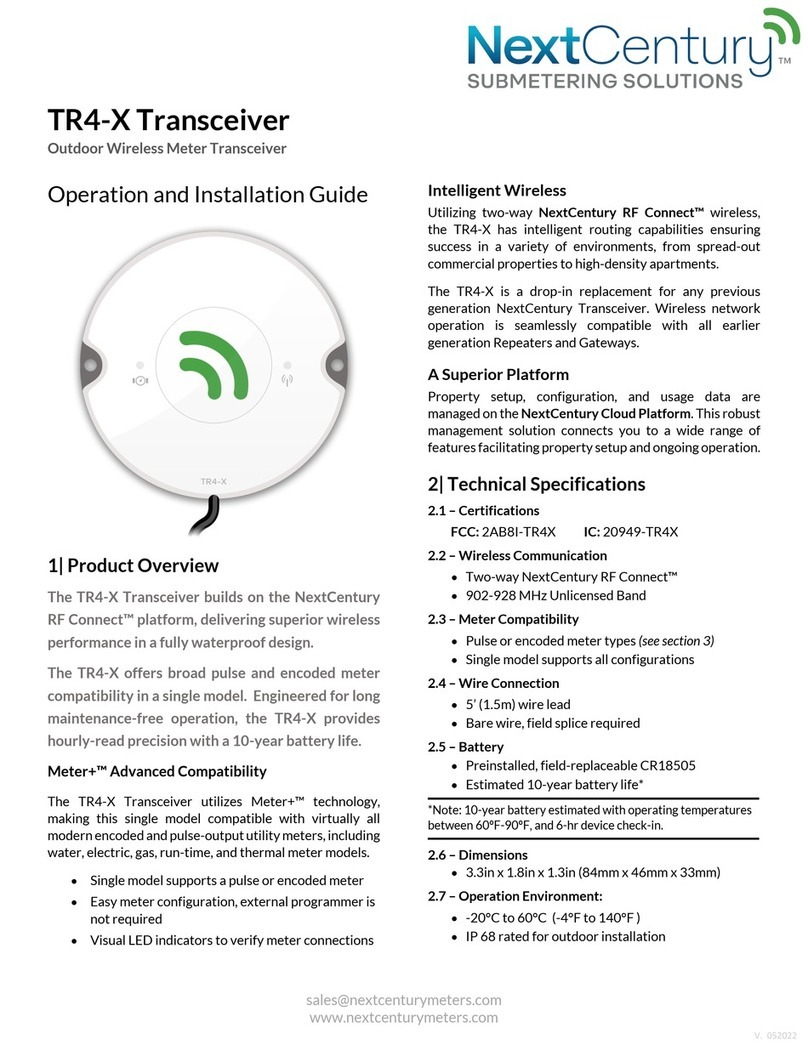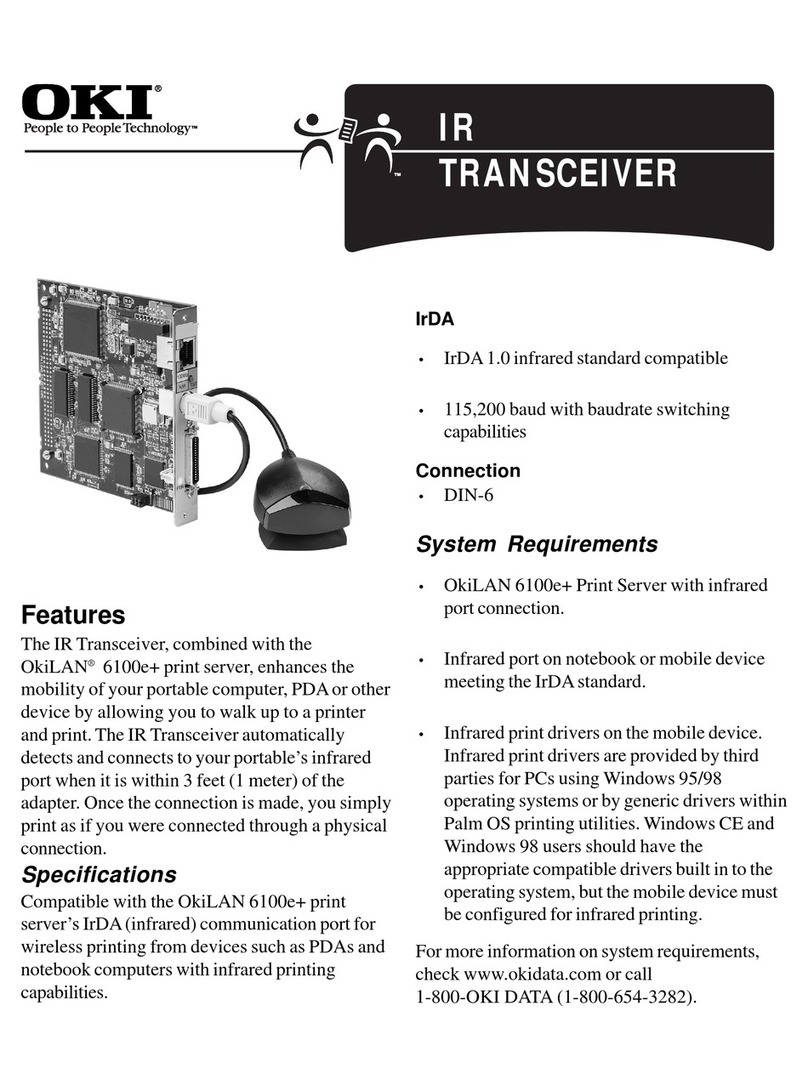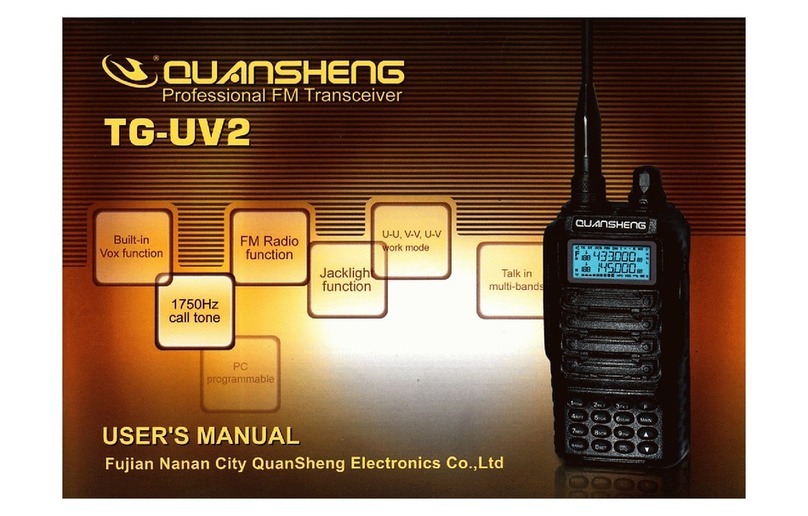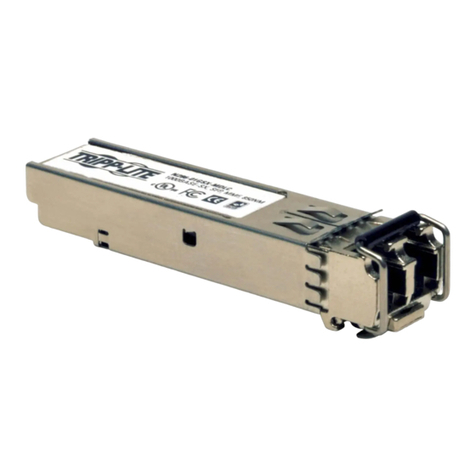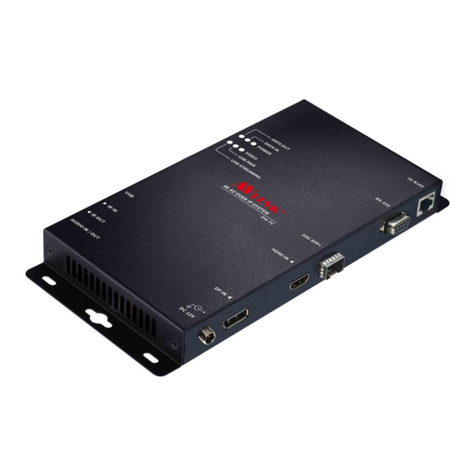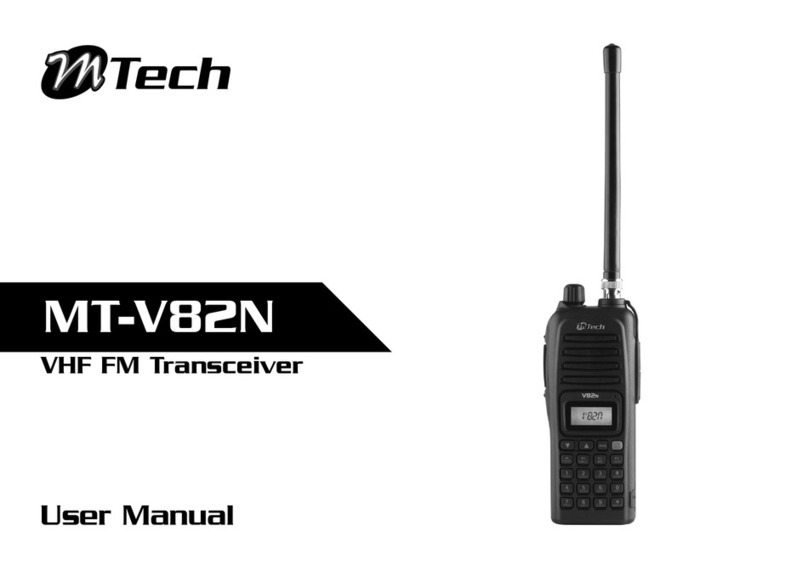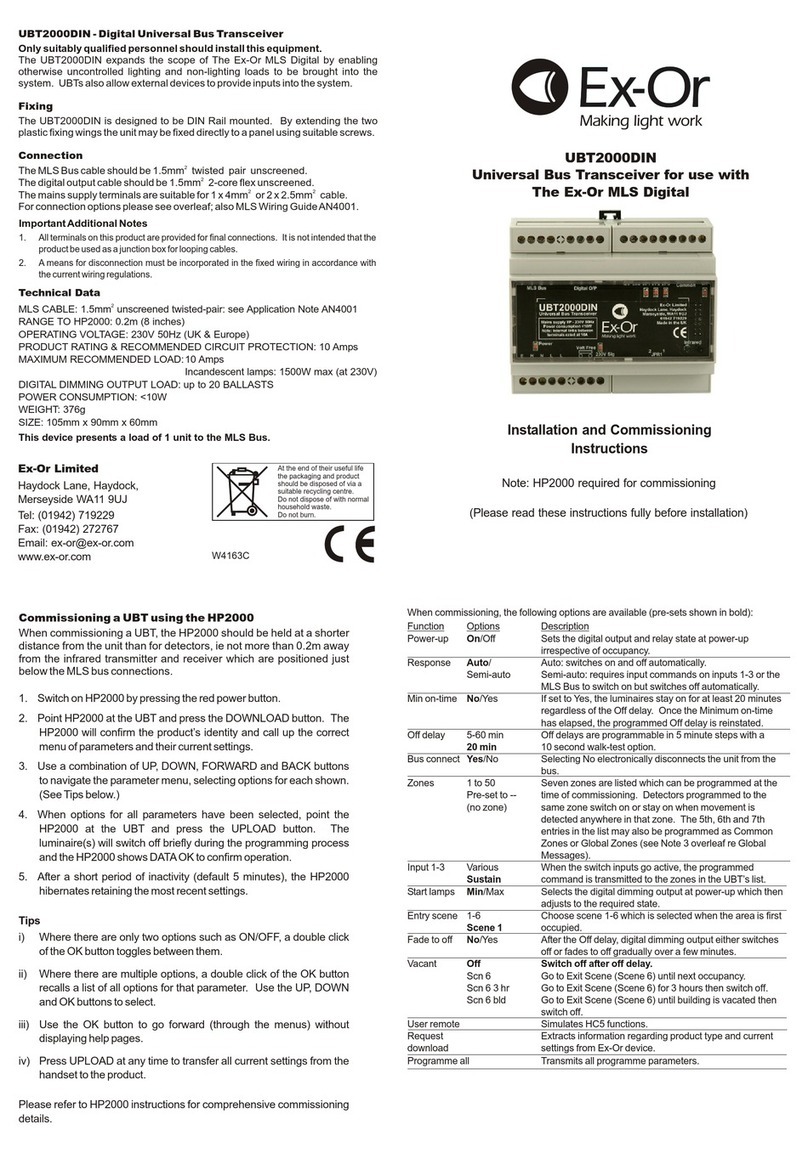Icom IC-7100 User manual

INSTRUCTION MANUAL
i7100
HF/VHF/UHF ALL MODE TRANSCEIVER
This device complies with Part 15 of the FCC Rules. Operation
is subject to the following two conditions: (1) this device may
not cause harmful interference, and (2) this device must accept
any interference received, including interference that may cause
undesired operation.
WARNING: MODIFICATION OF THIS DEVICE TO RECEIVE
CELLULAR RADIOTELEPHONE SERVICE SIGNALS IS
PROHIBITED UNDER FCC RULES AND FEDERAL LAW.

i
FOREWORD
Thank you for purchasing this fine Icom product. The IC-7100
h f /v h f /u h f a l l m o d e t r a n s c e i v e r is designed and build with
Icom’s superior technology and craftsmanship combining tra-
ditional analog technologies with the new digital technology,
Digital Smart Technologies for Amateur Radio (D-STAR), for
a balanced package. With proper care, this product should
provide you with years of trouble-free operation.
We thank you for making your IC-7100 your radio of choice,
and hope you agree with Icom’s philosophy of “technology
first.” Many hours or research and development went into the
design of your IC-7100.
FEATURES
❍IF DSP features
❍All mode capability covering 160–2 m and
70 cm (depending on version)
❍Compact with separated front panel
❍±0.5 ppm of high frequency stability
❍Baudot RTTY demodulator
❍Selectable SSB transmission passband
width (For both higher and lower pass
frequency)
❍Standard voice synthesizer/voice recorder
❍SD card slot ready for several memory
storage
❍Voice recorder to records your communication
❍DV mode (Digital voice + Low-speed data
communication) operation-ready
– Text message and call sign exchange
– Transmit position data
❍DR (D-STAR Repeater) mode and repeater
list allow you to easily operate using a
D-STAR repeater
EXPLICIT DEFINITIONS
WORD DEFINITION
RDANGER! Personal death, serious injury or an ex-
plosion may occur.
RWARNING! Personal injury, fire hazard or electric
shock may occur.
CAUTION Equipment damage may occur.
NOTE Recommended for optimum use. No risk
of personal injury, fire or electric shock.
IMPORTANT
READ ALL INSTRUCTIONS carefully and completely
before using the transceiver.
SAVE THIS INSTRUCTION MANUAL— This
instruction manual contains important operating instructions
for the IC-7100.
FCC INFORMATION
• FOR CLASS B UNINTENTIONAL RADIATORS:
This equipment has been tested and found to comply with the
limits for a Class B digital device, pursuant to part 15 of the
FCC Rules. These limits are designed to provide reasonable
protection against harmful interference in a residential instal-
lation. This equipment generates, uses and can radiate radio
frequency energy and, if not installed and used in accordance
with the instructions, may cause harmful interference to radio
communications. However, there is no guarantee that inter-
ference will not occur in a particular installation. If this equip-
ment does cause harmful interference to radio or television
reception, which can be determined by turning the equipment
off and on, the user is encouraged to try to correct the inter-
ference by one or more of the following measures:
•Reorientorrelocatethereceivingantenna.
•Increasetheseparationbetweentheequipmentandre-
ceiver.
•Connecttheequipmentintoanoutletonacircuitdifferent
from that to which the receiver is connected.
•Consultthedealeroranexperiencedradio/TVtechnician
for help.
Icom, Icom Inc. and the Icom logo are registered trademarks
of Icom Incorporated (Japan) in Japan, the United States,
the United Kingdom, Germany, France, Spain, Russia and/
or other countries.
Spurious signals may be received near some frequen-
cies.
These are created in the internal circuit and does not
indicate a transceiver malfunction.
CAUTION: Changes or modifications to this device,
not expressly approved by Icom Inc., could void your
authority to operate this device under FCC regula-
tions.
“AI” means “Advanced Instructions.”
“sec. MM” means section number.
So when “(AI sec. MM)” is described on this manu-
al, see the PDF type Advanced Instruction’s section
number for your reference.

ii
PRECAUTIONS
RDANGER HIGH VOLTAGE! NEVER touch an an-
tenna or internal antenna connector during transmission. This
may result in an electrical shock or burn.
RWARNING RF EXPOSURE! This device emits
Radio Frequency (RF) energy. Extreme caution should
be observed when operating this device. If you have
any questions regarding RF exposure and safety stan-
dards please refer to the Federal Communications
Commission Office of Engineering and Technology’s
report on Evaluating Compliance with FCC Guidelines
for Human Radio Frequency Electromagnetic Fields
(OET Bulletin 65).
RWARNING! NEVER operate the transceiver while
driving a vehicle. Safe driving requires your full attention—
anything less may result in an accident.
RWARNING! NEVER operate the transceiver with
an earphone, headphones or other audio accessories
at high volume levels. Hearing experts advise against
continuous high volume operation. If you experience a
ringing in your ears, reduce the volume level or discon-
tinue use.
RWARNING! NEVER apply AC power to the [DC13.8V]
connector on the transceiver rear panel. This could cause a
fire or damage the transceiver.
RWARNING! NEVER apply more than 16 V DC to the
[DC13.8V] connector on the transceiver rear panel or use re-
verse polarity. This could cause a fire or damage the trans-
ceiver.
RWARNING! NEVER cut the DC power cable between
the DC plug and fuse holder. If an incorrect connection is
made after cutting, the transceiver might be damaged.
RWARNING! NEVER let metal, wire or other objects
touch any internal part or connectors on the rear panel of the
transceiver. This may result in an electric shock or this could
cause a fire or damage the transceiver.
RWARNING! NEVER operate or touch the trans-
ceiver with wet hands. This may result in an electric
shock or may damage the transceiver.
RWARNING! Immediately turn the transceiver power
OFF and remove the power cable if it emits an abnormal
odor, sound or smoke. Contact your Icom dealer or dis-
tributor for advice.
CAUTION: NEVER expose the transceiver to rain, snow
or any liquids.
CAUTION: NEVER change the internal settings of
the transceiver. This may reduce transceiver perfor-
mance and/or damage to the transceiver.
DO NOT operate the transceiver near unshielded elec-
trical blasting caps or in an explosive atmosphere.
DO NOT use harsh solvents such as benzine or al-
cohol to clean the transceiver, as they will damage the
transceiver’s surfaces. If the transceiver becomes dusty
or dirty, wipe it clean with a soft, dry cloth.
DO NOT use or place the transceiver in areas with tem-
peratures below –10°C (+14°F) or above +60°C (+140°F). Be
aware that temperatures on a vehicle’s dashboard can ex-
ceed +80°C (+176°F), resulting in permanent damage to the
transceiver if left there for extended periods.
DO NOT place the transceiver in excessively dusty environ-
ments or in direct sunlight.
DO NOT place the transceiver against walls or putting any-
thing on top of the transceiver. This will obstruct heat dissipa-
tion.
Place the transceiver in a secure place to avoid inadvertent
use by children.
During mobile operation, NEVER place the transceiver
where air bag deployment may be obstructed.
During mobile operation, DO NOT place the transceiver
where hot or cold air blows directly onto it.
During mobile operation, DO NOT operate the transceiver
without running the vehicle’s engine. When the transceiver’s
power is ON and your vehicle’s engine is OFF, the vehicle’s
battery will soon become exhausted.
Make sure the transceiver power is OFF before starting the
vehicle engine. This will avoid possible damage to the trans-
ceiver by ignition voltage spikes.
During maritime mobile operation, keep the transceiver and
microphone as far away as possible from the magnetic navi-
gation compass to prevent erroneous indications.
BE CAREFUL! The rear panel will become hot when op-
erating the transceiver continuously for long periods of time.
BE CAREFUL! If a linear amplifier is connected, set the
transceiver’s RF output power to less than the linear ampli-
fier’s maximum input level, otherwise, the linear amplifier will
be damaged.
Use Icom microphones only (supplied or optional). Other
manufacturer’s microphones have different pin assignments,
and connection to the IC-7100 may damage the transceiver.

iii
e
SUPPLIED ACCESSORIES
The following accessories are supplied with the transceiver.
q Hand microphone ............................................... 1
w Control cable....................................................... 1
eFerrite EMI filter ................................................... 1
For European versions ............... 2
r3.5 (d) mm plug.................................................... 1
tACC cable............................................................ 1
y DC power cable* (OPC-1457) ............................ 1
or (OPC-2095) ............................ 1
u Spare fuse (ATC 5 A) ......................................... 1
iUSB cable ............................................................ 1
oCD........................................................................ 1
!0 Spare fuse (ATC 30 A) ....................................... 2
* Depending on the version.
q
w e
r
ty
y
u
i
o!0
ABOUT THE SUPPLIED CD
The following instructions and installers are included on
the CD.
• Basic instructions
Instructions for the basic operations, the same as
this manual
• Advanced Instructions
Instructions for the advanced operations and more
details are described than in this manual
• Schematic diagram
Includes the schematic and block diagrams
• HAM radio Terms
A glossary of HAM radio terms
• Adobe® Reader® Installer
Installer for Adobe®Reader®
A PC with the following Operating System is required.
•Microsoft®Windows® 8, Microsoft®Windows® 7, Mi-
crosoft®Windows Vista®or Microsoft®Windows® XP
Starting the CDD
Insert the CD into the CD drive.q
•Doubleclick“Autorun.exe”ontheCD.
•Dependingonthe PC setting,theMenu screenshown
below is automatically displayed.
Click the desired button to open the file.w
•ToclosetheMenuscreen,click[Quit].
To read the guide or instructions, Adobe®Reader®is
required. If you have not installed it, please install the
Adobe®Reader®on the CD or downloaded it from Ado-
be Systems Incorporated’s web
site.
QuitsthemenuscreenInstalls the Adobe®Reader®
Opens the
Glossary
Opens the
Basic
Instructions
(this manual)
Opens the
Advanced
Instructions
Opens the
Schematic
diagram
(See p. 2-7 for installation details)
For European versions

Controller — Front panel ........................................................1-2
Controller — Function display ...............................................1-7
Controller — Multi-function keys ...........................................1-10
M-1 (M-1 menu) DisplayD..........................................................1-10
M-2 (M-2 menu) DisplayD..........................................................1-10
M-3 (M-3 menu) DisplayD..........................................................1-10
D-1 (D-1 menu) DisplayD...........................................................1-10
D-2 (D-2 menu) DisplayD...........................................................1-10
Function keys on M-1 displayD..................................................1-10
Function keys on M-2 displayD..................................................1-10
Function keys on M-3 displayD..................................................1-11
Function keys on D-1 displayD..................................................1-12
Function keys on D-2 displayD..................................................1-12
Controller — Rear and bottom panels...................................1-13
Main unit — Front panel..........................................................1-14
Main unit — Rear panel...........................................................1-14
ACC socket informationD...........................................................1-16
DATA2 socket informationD........................................................1-17
Microphone connector informationD..........................................1-17
Microphone ..............................................................................1-18
HM-198 (Supplied)D..................................................................1-18
SM-50D(Option)........................................................................1-18
SM-30D(Option)........................................................................1-18
HM-151D(Option)......................................................................1-19
Section 1 PANEL DESCRIPTION
Section 2 INSTALLATION AND CONNECTIONS
Section 3 BASIC OPERATION
Section 4 D-STAR INTRODUCTION
Section 5 D-STAR OPERATION <BASIC>
Section 6 SET MODE
Section 7 INSTALLATION NOTES
1-1
Section 1PANEL DESCRIPTION
1-1
“AI” means “Advanced Instructions.”
“sec. MM” means section number.
So when “(AI sec. MM)” is described on this manual, see the PDF type
Advanced Instruction’s section number for your reference.

1PANEL DESCRIPTION
1-2
Controller — Front panel
q POWER SWITCH•AF VOLUME [PWR]•[AF]
(p. 3-2)
Push to turn ON the transceiver power.➥
•First,conrmtheDCpowersourceisturnedON.
Hold down for 1 second to turn OFF the power.➥
Rotate to adjust the audio output level.➥
Increases
Decreases
wRF GAIN CONTROL/ SQUELCH CONTROL
[RF/SQL] (p. 3-19)
Rotate to adjust the RF gain and squelch threshold
levels.
The squelch removes noise output to the speaker
when no signal is received. (closed condition)
•ThesquelchisparticularlyeffectiveforAMandFM,but
also works in other modes.
•The12to1o’clockpositionisrecommendedforthemost
effectiveuseofthe[RF/SQL]control.
•[RF/SQL]operatesas only anRF gain controlinSSB,
CW and RTTY (Squelch is fixed open), or a squelch con-
trol in AM, FM, WFM and DV (RF gain is fixed at maxi-
mum sensitivity),when“Auto”isselectedasthe“RF/SQL
Control” item in the “Function” Set mode. (p. 6-5)
SET
> Function > RF/SQL Control
• When used as an RF gain/squelch control
Maximum
RF gain
S-meter
squelch
Noise squelch (FM/DV modes)
Squelch is
open.
RF gain
adjustable
range
Recommended level
• When used as an RF gain control
(Squelch is fixed open; SSB, CW and RTTY only)
Minimum RF gain
Adjustable
range
Maximum
RF gain
While rotating the RF gain control, a faint noise may
be heard. This comes from the DSP unit and does
not indicate an equipment malfunction.
• When used as a squelch control
(RF gain is fixed at maximum.)
Squelch is
open.
S-meter
squelch
S-meter squelch
threshold
Noise squelch
threshold
(FM/DV modes)
Shallow Deep
Noise squelch (FM/DV modes)
PBT RIT
TX / RX
PWR
AF RF/SQL
CLR
M-CH BANK
RIT
TUNER/CALL
MENU
MIC/RF PWR
NB
SPEED/PITCH
SET
QUICK
NOTCH
DR
AUTO
TUNE
RX
�
CS
XFC
SPEECH
MPAD
NR
P.AMP
ATT
i7100
w
q
e
y
u
io !0 !1
t
r

1
PANEL DESCRIPTION
1-3
eTX/RX LED
Lights green when the squelch opens, or a signal➥
is received.
Lights red when transmitting.➥
r MEMORY BANK CONTROL [BANK]
❍When both the PBT and RIT LEDs are OFF
Rotate to select a Memory bank.
❍When the PBT LED (y) lights green
(Mode: SSB/CW/RTTY/AM)
Rotate to adjust the receiver’s IF filter passband
width using the DSP circuit.
❍When the RIT LED (u) lights orange
Disable this control.
t
M-CH CONTROL•CLEAR SWITCH [M-CH]•[CLR]
Push to select the action of the [M-CH/BANK] con-
trols as the Memory/Bank selection, PBT control or
RIT control.
❍When the both RIT and PBT LEDs are OFF
Rotate to select a Memory channel.
❍When the RIT LED lights orange
➥Rotate to adjust the RIT frequency shift.
•The frequencyshift rangeis±9.99 kHz in10 Hz
steps.The control tunes in 1 Hz steps when the op-
erating frequency readout is set to the 1 Hz step.
➥Hold down for 1 second to clear the RIT shift
frequency.
✔What is the RIT function?
The RIT (Receiver Incremental Tuning) shifts the re-
ceive frequency without shifting the transmit frequency.
This is useful for fine tuning stations calling you off-fre-
quency, or when you prefer to listen to slightly different-
sounding voice characteristics.
❍When the PBT LED lights green
(Mode: SSB/CW/RTTY/AM)
➥Rotate to adjust the receiver’s IF filter pass-
band width using the DSP circuit.
➥
Hold down for 1 second to reset the PBT set-
tings.
•ThePBTisadjustablein50HzstepsintheSSB/
CW/RTTY modes, and 200 Hz in the AM mode. At
that time, the shift value changes in 25 Hz steps in
the SSB/CW/RTTY modes, and 100 Hz in the AM
mode.
•ThePBTcontrolsfunctionasanIFshiftcontrol.
✔What is the PBT control?
The PBT function electronically modifies the IF pass-
band width to reject interference. This transceiver uses
the DSP circuit for the PBT function.
y PBT LED
Lights green when the [M-CH/BANK] controls act
as the PBT control.
•Pushthe[M-CH] switch to select PBT control.
uRIT LED
Lights orange when the RIT function is turned ON.➥
Lights orange when the [M-CH/BANK]➥controls
act as the RIT control.
•Pushthe[M-CH] switch to select RIT control.
•The RIT control is the inner control. The outer control
is disabled.
i RIT KEY
RIT
(AI sec. 5)
Push to turn the RIT function ON or OFF.➥
•Usethe[M-CH] control to vary the RIT frequency.
➥Hold down for 1 second to add the shift frequency
of the RIT function to, or subtract it from, the dis-
played frequency.
o ANTENNA TUNER/CALL KEY
TUNER/CALL
❍ANTENNA TUNER KEY Operation (AI sec. 16)
(Frequency band: HF/50 MHz)
➥Push to turn an optional automatic antenna
tuner ON or OFF (bypass).
➥Hold down for 1 second to manually tune the
antenna tuner.
•Ifthetunercannottunetheantennawithin20sec-
onds, the tuning circuit is automatically bypassed.
❍CALL KEY Operation (AI sec. 11)
(Frequency band: 144/430 MHz)
Push to select the Call channel.
In the 70 MHz band, push to sound an error beep.
!0 MENU KEY
MENU
(p. 1-10)
Push to change the set of functions assigned to the
touch keys.
•TogglesthefunctiondisplaymenubetweenM-1,M-2and
M-3 menus or D-1 and D-2 menus.
!1 MIC GAIN/RF POWER ADJUSTMENT KEY
MIC/RF PWR
(p. 3-24)
Push to open the MIC gain/RF power adjustment
display.
•Rotate[M-CH] to adjust the MIC gain.
•Rotate[BANK] to adjust the RF power.
Frequency band RF output power range
HF/50 MHz 2 to 100 W (AM: 1 to 30 W)
70 MHz* 2 to 50 W (AM: 1 to 15 W)
144 MHz 2 to 50 W
430 MHz 2 to 35 W
•Pushagaintoclosethewindow.
* 70 MHz band transmission is available, depending on the
transceiver version.

1PANEL DESCRIPTION
1-4
!2 NOISE BLANKER KEY
NB
(AI sec. 5)
(Mode: SSB/CW/RTTY/AM)
Push to turn the noise blanker ON or OFF.➥
The noise blanker reduces pulse-type noise such
as that generated by vehicle ignition systems.The
noise blanker is not effective for non-pulse-type
noise.
•“NB”appearswhenthenoiseblankerisON.
Hold down for 1 second to display the “NB” screen.➥
Push to return to the previous screen.
!3 KEY SPEED/CW PITCH ADJUSTMENT KEY
SPEED/PITCH
(AI sec. 4, 6)
Push to open the Key speed/CW pitch adjustment
display.
•Rotate[M-CH] to adjust the keying speed of the inter-
nal electronic CW keyer to between 6 wpm (minimum)
and 48 wpm (maximum).
•Rotate [BANK] to shift the received CW audio pitch
and the CW sidetone pitch without changing the operat-
ing frequency.
•TheCWpitchcanbeadjustedfrom300to900Hzinap-
proximately 5 Hz steps.
•Pushagaintoclosethewindow.
!4 NOISE REDUCTION KEY
NR
(AI sec. 5)
Push to turn DSP noise reduction ON or OFF.➥
•“NR”appearswhennoisereductionisON.
Hold down for 1 second to display the “NR” screen.➥
Push to return to the previous screen.
•Rotate the Dial to adjust the DSP noise reduction
level. Set for maximum readability.
!5 PREAMP•ATTENUATOR KEY
P.AMP
ATT
❍PREAMP KEY Operation (AI sec. 5)
(Frequency band: HF, 50/70 MHz)
Push to select one of two receive RF preampli-
fiers, or to bypass them.
•“P.AMP1”isawidedynamicrangepreamplier.Itis
most effective for the 1.8 to 21 MHz bands.
•“P.AMP2”isahigh-gainpreamplier.Itismosteffec-
tive for the 24 to 70 MHz bands.
•Noindicatorappearswhenthepreampliersarenot
selected.
✔What is the preamplifier?
The preamplifier amplifies signals in the front end
to improve the S/N ratio and sensitivity. Select “P.
AMP1” or “P. AMP2” when receiving weak sig-
nals.
(Frequency band: 144/430 MHz)
Push to turn the preamplifier ON or OFF.
•“P.AMP”appearswhenthepreamplierisON.
❍ATTENUATOR KEY Operation (AI sec. 5)
➥Hold down for 1 second to turn ON the attenu-
ator.
•“ATT”appearswhentheattenuatorisON.
➥Push to turn OFF the attenuator.
•“ATT”disappears.
✔What is the attenuator?
The attenuator prevents a desired signal from be-
ing distorted when very strong signals are near it,
or when very strong electromagnetic fields, such
as from a broadcasting station, are near your lo-
cation.
Controller — Front panel (Continued)
PBT RIT
TX / RX
PWR
AF RF/SQL
CLR
M-CH BANK
RIT
TUNER/CALL
MENU
MIC/RF PWR
NB
SPEED/PITCH
SET
QUICK
NOTCH
DR
AUTO
TUNE
RX
�
CS
XFC
SPEECH
MPAD
NR
P.AMP
ATT
i7100
!2 !4!3 !5 !7 !8!6 @0 @1!9

1
PANEL DESCRIPTION
1-5
!6 NOTCH KEY
NOTCH
(AI sec. 5)
(Mode = Auto notch: SSB/AM/FM
Manual notch: SSB/CW/RTTY/AM)
➥In the SSB and AM modes, push to toggle the
notch function between auto, manual and OFF.
•EithertheAutoorManualnotchfunctioncanbeturned
OFF in
the “[NOTCH] Switch (SSB)/(AM)” items
of the
“Function” Set mode. (6-21)
SET
> Function > [NOTCH] Switch (SSB)
SET
> Function > [NOTCH] Switch (AM)
➥In the FM mode, push to turn the Auto Notch func-
tion ON or OFF.
➥In the CW or RTTY mode, push to turn the Manual
Notch function ON or OFF.
•“MN” appears when the Manual Notch function is
ON.
•“AN”appearswhentheAutoNotchfunctionisON.
•NoindicatorappearswhenthenotchlterisOFF.
➥Hold down for 1 second to display the “NOTCH”
screen.
Push to return to the previous screen.
•RotatetheDialtoadjustthenotchfrequencytoreject
an interfering signal when the manual function is ON.
•Notchltercenterfrequency:
SSB/RTTY: –1040 Hz to +4040 Hz
CW: CW pitch frequency –2540 Hz to
CW pitch frequency +2540 Hz
AM: –5060 Hz to +5100 Hz
✔What is the notch filter?
The notch filter is a narrow filter that eliminates un-
wanted CW or AM carrier tones, while preserving
the desired voice signal. The DSP circuit automati-
cally adjusts the notch frequency to effectively elimi-
nate unwanted tones.
!7 DR MODE KEY
DR
(section 4, 5, AI sec. 9)
➥Push to select the DR mode.
•WhentheDRmodeisselected,thetransceiverauto-
matically selects the DV mode.
➥In the DR mode, push to cancel it.
•Thetransceiverreturnstothepreviousscreenbefore
entering the DR mode.
!8 SET MODE KEY
SET
(section 6)
➥Push to enter or exit the SET mode.
•“VoiceMemo,”“CallSign,”“RXHistory,”“DVMemory,”
“MyStation,”“DVSet,”“GPS,”“SPEECH,”“QSO/RX
Log,” “Function,” “Tone Control,” “Connectors,” “Dis-
play,” “Time Set,” “SD Card” and “Others” set group
are selectable.
!9 QUICK MENU KEY
QUICK
➥PushtoopenorclosetheQuickMenuwindow.
•TheQuickMenuisusedtoquicklyselectvarious
functions.
➥In the setting screen, push to open the Default
set window.
•Touch“Default”toresettothedefaultsetting.
@0 AUTO TUNE•RXCS KEY
AUTO TUNE
RX�CS
❍AUTO TUNE KEY Operation (AI sec. 4)
(Mode: CW)
➥Push to automatically adjust for a zero beat
with the received signal.
Zero beat means that two signals are exactly the
same frequency.
•“AUTOTUNE”blinkswhentheautotunefunction
is activated.
•WhentheRITfunctionisON,theautotunefunc-
tion changes the RIT frequency, not the displayed
frequency.
❍RX CALL SIGN CAPTURE KEY Operation
(p. 5-6)
(Mode: DV, when the DR mode is selected)
➥Push to open the “RX>CS” screen.
Push again to return to the previous screen.
➥Hold down for 1 second to set the received call
signs (station and repeaters) as the operating
call sign.
@1
TRANSMIT FREQUENCY CHECK KEY
XFC
➥
During split frequency or repeater operation, hold
down to listen to the transmit frequency. (AI sec. 4)
•Whileholdingdownthisswitch,thetransmitfrequen-
cy can be changed with the Dial or
MPAD
.
•WhentheSplitLockfunctionisturnedONintheSplit
operation, hold down
XFC
to cancel the Dial lock
function.
➥When operating simplex, hold down to monitor
the frequency.
•Whileholdingdownthiskey,thesquelchisopenand
the interference reject function is temporarily turned
OFF.
➥When operating simplex and the RIT function is
turned ON, hold down to listen to the transmit fre-
quency. The frequency is the same as when the
RIT is OFF.
➥In the DV mode, hold down this key to select the
RX monitoring mode. (p. 6-3)
Other manuals for IC-7100
10
Table of contents
Other Icom Transceiver manuals
